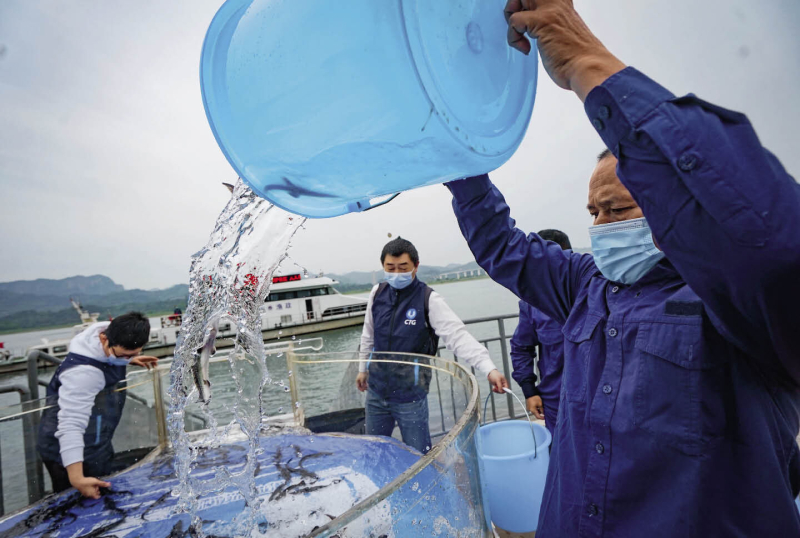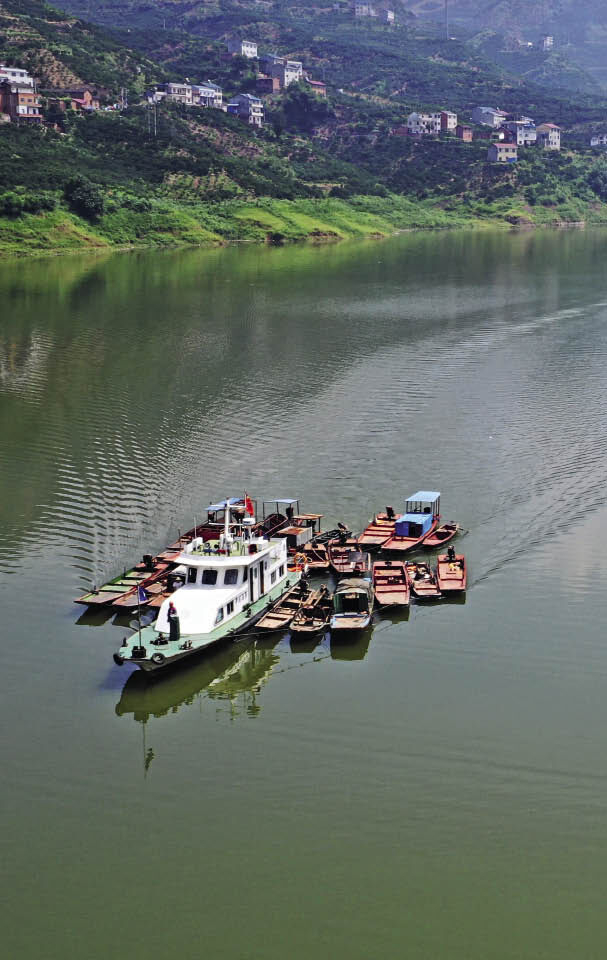
On April 22, 2020, at a station allocated for releasing rare fish in Yichang City, Hubei Province, 10,000 second-generation Chinese sturgeon are released back into the Yangtze River.
A Severe Challenge
“Removing and resettling nearly 300,000 fishermen in 11 provinces and municipalities is unprecedented in the history of governance on rivers and lakes,” said Professor Pan Yingjie, executive deputy director of the Strategy Research Center for the Yangtze River Ecological Protection and former president of Shanghai Ocean University. Pan added, “It shows our respect for nature, and the protection of aquatic biological resources is a promise made to future generations.”
The Yangtze River, reputed as the mother river of the Chinese nation, is one of the most famous rivers in the world for having the most abundant aquatic creatures. From Qinghai in northwest China to the coastal city of Shanghai, it flows through 11 provinces and municipalities, and enters into the East China Sea at Chongming Island. There are more than 4,300 kinds of aquatic life living in the river, with over 430 kinds of fish species, 170 of which are rare. As a cradle of freshwater fisheries, the Yangtze River serves as the original breeding ground of numerous economic fish and the world’s most important freshwater biological gene bank.
However, the ecological environment of the Yangtze River basin has deteriorated significantly, and the biodiversity of the river has decreased in past years due to an increase of intensive human activities such as building dams, overfishing, mining, and quarrying, which greatly polluted the water as a result. Rare fish species such as Chinese sturgeon, Yangtze sturgeon, and Yangtze finless porpoise are on the verge of extinction, and commercial fishery stock is almost exhausted. The number of herring, grass carp, silver carp, and bighead carp — the four major fish species that are usually abundant in China — dropped by 90 percent compared to that in the 1950s.
Fishermen lay fishing meshes with extremely small holes underwater. Once fish swim in, big or small, they will be trapped and unable to escape. This unsustainable fishing method has caused a vicious circle of “the less resources there are, the worse the ecological environment gets, and poorer the fishermen become.”
In 2002, the middle and lower reaches of the Yangtze River began a trial run of implementing a three-month spring fishing ban; The next year, it was officially implemented in the Yangtze River basin after it was approved by the State Council; and in 2017, the fishing ban was extended to four months. The previous policies have played a crucial role in conserving aquatic resources and protecting the ecological environment, but they cannot reverse the deteriorating trend of the fishery resources.

On July 29, 2020, in Guojiaba Town of Zigui County in Yichang City, Hubei Province, a maritime vessel tows fishing boats out of the waters as a 10-year fishing ban on the Yangtze River is already in place.
The average annual catch of fisheries along the Yangtze River has dropped from 42,700 tons in 1954 to less than 10,000 tons today, accounting for merely 0.15 percent of the country’s total output of aquatic products. The fish on the Chinese market mostly come from fish farms. Artificial bred fish face genetic degradation after generations of reproduction, and it is necessary for the artificial ones to mix with high-quality wild fish to improve the population in their natural evolution. In this sense, protecting the Yangtze River helps save the natural germplasm resource bank.
“The ban on fishing is a key action to reverse the deterioration of the ecological environment and is of great significance for the protection of the river and the green development of the Yangtze River Economic Belt,” Yu noted.
Multiple Actions
The 10-year ban in the Yangtze River basin is a long-term systematic project, and the implementation of relevant policies is not that easy.
Tang Yi, dean of the School of Ocean Culture and Law of Shanghai Ocean University and deputy director of the Strategy Research Center for Yangtze River Water Ecological Protection, believes that the first thing needed to be done is withdrawing 100,000 fishing boats and nearly 300,000 fishermen from the area. In addition, illegal fishing along the river must be cracked down on. “The fishing ban cannot be achieved by the fishery authority alone,” Tang said, “Joint efforts from other relevant departments are crucial.”
“Why is illegal fishing, for example electrofishing, banned, but then occurs again?” Pan explained, “Because there is the market demand for wild fish and shrimp from the Yangtze River, it is difficult for people to resist the temptation of earning more money.” Fortunately, the government has begun to strike a severe blow on illegal operations as well as the processing and sales of illegal catch, thus cutting the chain of illegal fishing in the Yangtze River.
The Chishui River is an important habitat and breeding place for rare and unique fish in the upper reaches of the Yangtze River. Since January 1, 2017, all fishing activities have been banned in this river, which has also become the first primary tributary of the Yangtze River to implement the 10-year fishing ban.
“A river usually extends dozens of kilometers within a county, but the fishery law enforcement team has just a few people. It is almost impossible to prevent illegal fishing.” The local staff of the fishery supervision and management sighed, “The fishing ban only lasts for a few months each year. Fries are soon exposed to natural predators and human hunting.” Only the 10-year fishing ban on the entire river basin can give enough time for the restoration of aquatic life, enabling them to breed two or three generations, and thus the quantity and species of aquatic resources can be restored gradually and steadily.
For a long time, certain defects have existed in fishery law enforcement. The number of grassroots personnel has been insufficient, and the equipment they use is either outdated or in short supply. At present, the Fishery Administration Office of the Yangtze River basin is pushing the government at all levels to increase investment and personnel in fishery administration, and make full use of drones, video surveillance and other technologies. It is also building a cross-department law enforcement platform to strike a severe blow on intersection waters. In 2019, fishery administration departments at all levels carried out about 30,000 law enforcement actions and busted and punished 5,665 illegal fishing operations.
Law enforcement must be carried out in accordance with the law. At the end of 2019, the Draft Law of the People’s Republic of China on the Protection of the Yangtze River was deliberated on. In Article 34, it clearly stipulates that the state shall implement strict fishing regulations in key waters of the Yangtze River basin. The aquatic reserves in the Yangtze River basin are completely closed and all productive fishing is prohibited; within 10 years from the implementation of the law, productive fishing will be completely prohibited in the mainstream and important tributaries of the Yangtze River. Specific management measures and the scope of key water areas shall be formulated by relevant departments of the State Council. Illegal fishermen can be fined up to between RMB 50,000 and RMB 500,000; those who cause ecological damage shall pay for all the cost of ecological restoration; and if a crime is constituted, criminal liabilities shall be investigated according to the law.
Long-Term Interests
The fishing ban in the Yangtze River basin serves a twofold purpose. One is an objective requirement put forward as the result of the dwindling aquatic resources and decreasing biodiversity in the river. The second purpose is serving the long-term interests of fishermen. It breaks the competitive fishing among fishermen who could previously only survive on fishing since there is no land for them to grow crops on shore by offering them other employment options.
The resettlement of nearly 300,000 fishermen, most of whom are up in years, less educated, and have no other skills apart from fishing, presents another severe challenge. Deputy director general Song Xin of the employment promotion department of the Ministry of Human Resources and Social Security called for targeted resettlement plans which can create more local jobs, provide relevant training and follow-up services, and help fishermen secure new jobs.
Previously, fishermen who paid the fee for the fishery resource reproduction were licensed to fish legally; currently, governments are organizing county- and township-level officials to confirm the identification of fishermen house by house, checking their certificate number, operating water area, family condition, and employment willingness, and to timely announce the information to the public with one person in charge of filing the data and information.
“All the relevant information of fishing boats and fishermen will be reported before August 1, and will be used as a basis for the allocation of compensation funds, resettlement, social security, follow-up assistance, and assessment. No fishermen should be left behind,” Yu added.
Among the people making a living on the Chishui River, some are licensed fishermen, and some are coastal villagers who built boats to fish privately. With the goal of making better arrangements for them, the local government designated specific personnel to keep in close contact with the fishermen so as to know their needs and find out their family income. After 30 revisions, a set of work plans was eventually made out by the local government: for fishermen leaving the trade, everyone is given a certain living subsidy each year, those who face daily living difficulties are covered by a local minimum living guarantee, and those without houses are given priority to live in urban affordable housing; for fishermen who intend to start their own businesses, start-up funds and loan interest discounts are provided.
With the compensation funds, some fishermen have bought houses, moved their families to urban areas, or opened up small businesses; others have built up fish ponds to develop ecological farming to meet the rising demand for freshwater fish after the strict and long-lasting ban was put in place.
According to data from the Shanghai Municipal Commission of Agriculture, as of August 2019, 192 fishing boats and 1,262 fishermen in Shanghai had all withdrawn from fishing, and the Shanghai section of the Yangtze River has fully implemented the ban on fishing. Actually, as early as 2005, the local government had already provided fishermen with urban medical insurance and provided job training for fishermen, giving them priority to employment.
The fishermen of the Yangtze River have made personal sacrifices for the protection of the river and the green development of the economic belt. Helping them to live a better life during the transition from fishermen to farmers and urban workers has become a vital part for the success of the fishing ban in the Yangtze River basin.